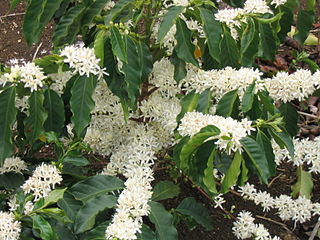
Coffea is a genus of flowering plants in the family Rubiaceae. Coffea species are shrubs or small trees native to tropical and southern Africa and tropical Asia. The seeds of some species, called coffee beans, are used to flavor various beverages and products. The fruits, like the seeds, contain a large amount of caffeine, and have a distinct sweet taste and are often juiced. The plant ranks as one of the world's most valuable and widely traded commodity crops and is an important export product of several countries, including those in Central and South America, the Caribbean and Africa.

Coffea arabica, also known as the Arabic coffee, is a species of flowering plant in the coffee and madder family Rubiaceae. It is believed to be the first species of coffee to have been cultivated and is currently the dominant cultivar, representing about 60% of global production. Coffee produced from the robusta bean makes up most of the remaining coffee production. Arabica coffee originates from and was first cultivated in Yemen, and documented by the 12th century. Coffea arabica is called بُنّ in Arabic, borrowed from the Amharic "Buna".
In West Africa, the Dahomey Gap refers to the portion of the Guinean forest-savanna mosaic that extends all the way to the coast in Benin, Togo, and Ghana, thus separating the forest zone that covers much of the south of the region into two separate parts. The forest region west of the gap is called the Upper Guinean forests or Guinean forest zone, and the portion east of the gap is called the Lower Guinean forests, Lower Guinean-Congolian forests, or Congolian Forest Zone.

Coffea canephora is a species of coffee that has its origins in central and western sub-Saharan Africa. It is a species of flowering plant in the family Rubiaceae. Though widely known as Coffea robusta, the plant is scientifically identified as Coffea canephora, which has two main varieties, robusta and nganda.

Cafestol is a diterpenoid molecule present in coffee beans. It is one of the compounds that may be responsible for proposed biological and pharmacological effects of coffee.

Gracillariidae is an important family of insects in the order Lepidoptera and the principal family of leaf miners that includes several economic, horticultural or recently invasive pest species such as the horse-chestnut leaf miner, Cameraria ohridella.
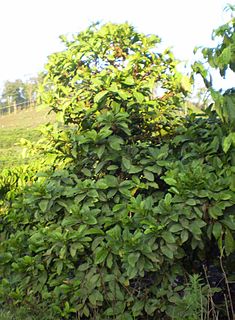
Coffea liberica, commonly known as the Liberian coffee, is a species of flowering plant in the family Rubiaceae from which coffee is produced. It is native to western and central Africa from Liberia to Uganda and Angola, and has become naturalised in the Philippines, Indonesia, Seychelles, the Andaman & Nicobar Islands, and Malaysia.

Kahweol is a diterpenoid molecule found in the beans of Coffea arabica and is structurally related to cafestol. Its name derives from the Arabic word ka-ah-wa, leading to the word, "coffee". In French, the related slang word "kawa" designates coffee.
Coffea charrieriana, also known as Charrier coffee, is a species of flowering plant from the Coffea genus. It is a caffeine-free coffee plant endemic to Cameroon in Central Africa. It is the first recorded caffeine-free Coffea in Central Africa, and the second to be recorded in Africa. The first caffeine-free species was previously discovered in Kenya, named C. pseudozanguebariae. The International Institute for Species Exploration at Arizona State University and a committee of taxonomists and scientists voted the C. charrieriana as one of the top 10 species described in 2008.
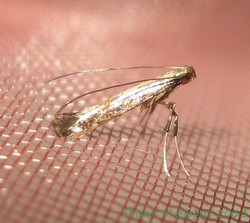
Phodoryctis caerulea is a moth of the family Gracillariidae. It is known from India, Malaysia (Sabah), Indonesia (Java), Sri Lanka, Fiji, Guam, the Solomon Islands, Japan and Taiwan, as well as Madagascar, Mauritius, Réunion, Uganda and Tanzania.
Acrocercops coffeifoliella is a moth of the family Gracillariidae. It is known from India, Sri Lanka, Indonesia (Java), Réunion and Madagascar.
Corythoxestis pentarcha is a moth of the family Gracillariidae. It is known from Réunion, Malaysia, and Sri Lanka. The hostplants for the species include Coffea robusta and Amomum magnificum.
Neurostrota brunnea is a moth of the family Gracillariidae. It is known from the Galápagos Islands.
Acrocercops zamenopa is a moth of the family Gracillariidae. It is known from Indonesia (Java).

Gracillariinae are a subfamily of moths which was described by Henry Tibbats Stainton in 1854.
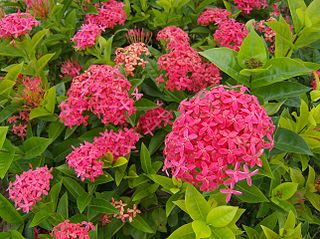
Ixoroideae is a subfamily of flowering plants in the family Rubiaceae and contains about 4000 species in 27 tribes.
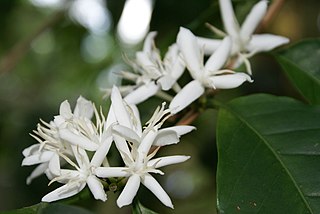
Coffeeae is a tribe of flowering plants in the family Rubiaceae and contains about 333 species in 11 genera. Its representatives are found in tropical and southern Africa, Madagascar, the western Indian Ocean, tropical and subtropical Asia, and Queensland.
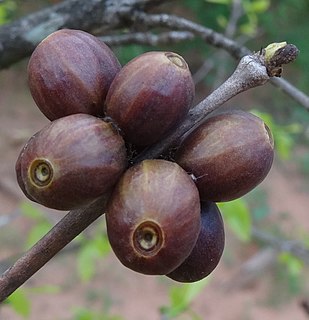
Coffea racemosa, also known as racemosa coffee and Inhambane coffee, is a species of flowering plant in the family Rubiaceae. It has naturally low levels of caffeine, less than half of that found in Coffea arabica, and a quarter of that in Robusta coffee. It is endemic to the coastal forest belt between northern KwaZulu-Natal in South Africa and Zimbabwe, found in an area less than 150 km2 (58 sq mi) in size. It was widely cultivated by the Portuguese during the 1960-1970s in Mozambique, currently there are only two plantations at Ibo Island and in Hluhluwe, which remain.
The Gassosa al caffè coffee is a typical Calabrese soft drink, fruit of the union of gassosa and coffee.










